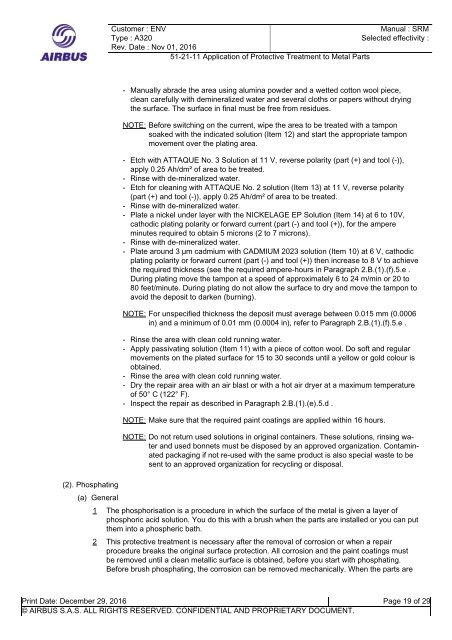You also want an ePaper? Increase the reach of your titles
YUMPU automatically turns print PDFs into web optimized ePapers that Google loves.
Customer : ENV<br />
Type : A<strong>320</strong><br />
Rev. Date : Nov 01, 2016<br />
<strong>51</strong>-<strong>21</strong>-<strong>11</strong> Application of Protective Treatment to Metal Parts<br />
Manual : <strong>SRM</strong><br />
Selected effectivity :<br />
(2). Phosphating<br />
(a) General<br />
- Manually abrade the area using alumina powder and a wetted cotton wool piece,<br />
clean carefully with demineralized water and several cloths or papers without drying<br />
the surface. The surface in final must be free from residues.<br />
NOTE: Before switching on the current, wipe the area to be treated with a tampon<br />
soaked with the indicated solution (Item 12) and start the appropriate tampon<br />
movement over the plating area.<br />
- Etch with ATTAQUE No. 3 Solution at <strong>11</strong> V, reverse polarity (part (+) and tool (-)),<br />
apply 0.25 Ah/dm² of area to be treated.<br />
- Rinse with de-mineralized water.<br />
- Etch for cleaning with ATTAQUE No. 2 solution (Item 13) at <strong>11</strong> V, reverse polarity<br />
(part (+) and tool (-)), apply 0.25 Ah/dm² of area to be treated.<br />
- Rinse with de-mineralized water.<br />
- Plate a nickel under layer with the NICKELAGE EP Solution (Item 14) at 6 to 10V,<br />
cathodic plating polarity or forward current (part (-) and tool (+)), for the ampere<br />
minutes required to obtain 5 microns (2 to 7 microns).<br />
- Rinse with de-mineralized water.<br />
- Plate around 3 µm cadmium with CADMIUM 2023 solution (Item 10) at 6 V, cathodic<br />
plating polarity or forward current (part (-) and tool (+)) then increase to 8 V to achieve<br />
the required thickness (see the required ampere-hours in Paragraph 2.B.(1).(f).5.e .<br />
During plating move the tampon at a speed of approximately 6 to 24 m/min or 20 to<br />
80 feet/minute. During plating do not allow the surface to dry and move the tampon to<br />
avoid the deposit to darken (burning).<br />
NOTE: For unspecified thickness the deposit must average between 0.015 mm (0.0006<br />
in) and a minimum of 0.01 mm (0.0004 in), refer to Paragraph 2.B.(1).(f).5.e .<br />
- Rinse the area with clean cold running water.<br />
- Apply passivating solution (Item <strong>11</strong>) with a piece of cotton wool. Do soft and regular<br />
movements on the plated surface for 15 to 30 seconds until a yellow or gold colour is<br />
obtained.<br />
- Rinse the area with clean cold running water.<br />
- Dry the repair area with an air blast or with a hot air dryer at a maximum temperature<br />
of 50° C (122° F).<br />
- Inspect the repair as described in Paragraph 2.B.(1).(e).5.d .<br />
NOTE: Make sure that the required paint coatings are applied within 16 hours.<br />
NOTE: Do not return used solutions in original containers. These solutions, rinsing water<br />
and used bonnets must be disposed by an approved organization. Contaminated<br />
packaging if not re-used with the same product is also special waste to be<br />
sent to an approved organization for recycling or disposal.<br />
1 The phosphorisation is a procedure in which the surface of the metal is given a layer of<br />
phosphoric acid solution. You do this with a brush when the parts are installed or you can put<br />
them into a phospheric bath.<br />
2 This protective treatment is necessary after the removal of corrosion or when a repair<br />
procedure breaks the original surface protection. All corrosion and the paint coatings must<br />
be removed until a clean metallic surface is obtained, before you start with phosphating.<br />
Before brush phosphating, the corrosion can be removed mechanically. When the parts are<br />
Print Date: December 29, 2016 Page 19 of 29<br />
© AIRBUS S.A.S. ALL RIGHTS RESERVED. CONFIDENTIAL AND PROPRIETARY DOCUMENT.


